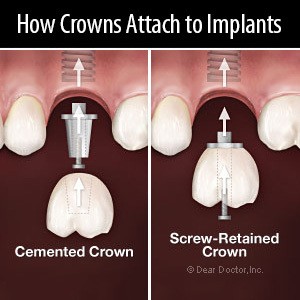
Have you ever wondered, how are crowns attached to dental implants? Dental implants offer a popular solution for replacing missing teeth, and the crown is the final step in the process. First, a small titanium post is surgically placed into the jawbone, serving as a sturdy foundation. After the implant integrates with the bone, it’s time to attach the crown. This process is akin to putting the cherry on top of a cake. The crown is meticulously crafted to match your natural teeth in shape, size, and color, ensuring a seamless, natural appearance. Using dental cement or a screw, the crown securely fastens to the implant, creating a durable and functional tooth replacement. Understanding how crowns attach to dental implants is fascinating, and it’s your path to a confident smile.
How are Crowns Attached Dental Implants?

How are Crowns Attached Dental Implants?
In the world of dentistry, dental implants have revolutionized the way we replace missing teeth. When a tooth is lost or extracted, a dental implant can provide a permanent solution that looks, feels, and functions like a natural tooth. One important aspect of the dental implant process is the attachment of a crown, which is the visible part of the tooth that sits above the gumline. Understanding how a crown is attached to a dental implant can help patients feel more informed and confident about their treatment.
The Dental Implant Process
The Dental Implant Process
- Understanding Dental Implants: Dental implants are titanium posts replacing tooth roots, integrating with the jawbone for stability.
- The Role of the Abutment: The abutment connects the implant to the crown, protruding through the gumline.
- Custom-Made Crown: A crown matching natural teeth in color, shape, and size is fabricated and attached to the abutment.
Attaching the Crown to the Abutment
- The Final Step: Attachment of the Crown: After ensuring full implant integration, the crown is positioned and secured using dental cement.
- Ensuring Proper Fit: The dentist ensures the crown fits well, blends with natural teeth, and doesn’t interfere with the patient’s bite.
The Importance of Proper Crown Attachment
- Dental Health: Proper attachment prevents bacterial infiltration, evenly distributes chewing forces, and supports long-term implant health.
- Functional Confidence: A well-attached crown allows patients to speak, eat, and smile with confidence, knowing their dental implant is secure.
Benefits of Crown-Attached Dental Implants
- Aesthetic Appeal: The custom-made crown offers a natural appearance and a cohesive smile.
- Functional Benefits: Crown-attached dental implants function like natural teeth, allowing for ease of eating, clear speech, and bone preservation.
Versatility and Longevity of Dental Implants
- Versatile Solution: Dental implants can replace single or multiple teeth, providing flexibility for patients.
- Longevity and Oral Health: Dental implants have a high success rate and can last a lifetime with proper care, preserving adjacent teeth and supporting long-term oral health.
Conclusion
Understanding how a crown is attached to a dental implant is essential for anyone considering this tooth replacement option. The dental implant process involves the surgical placement of a titanium post, followed by the attachment of an abutment and a custom-made crown. Proper attachment of the crown ensures stability, functionality, and aesthetic appeal. Dental implants with attached crowns offer natural-looking results, improved oral function, and long-term durability. By choosing dental implants, patients can enjoy a confident smile that lasts a lifetime.
Key Takeaways: How are Crowns Attached Dental Implants?
- A dental implant serves as the foundation for a crown in a tooth replacement procedure.
- The crown is custom-made to match the shape, size, and color of the patient’s natural teeth.
- The crown is attached to the dental implant using a small screw or dental cement.
- Once attached, the crown looks and functions like a natural tooth, allowing the patient to eat and speak comfortably.
- Regular dental check-ups and proper oral hygiene are essential for maintaining the longevity of the crown and dental implant.
Frequently Asked Questions
How is a crown attached to a dental implant?
A dental implant, typically made of titanium, replaces a missing tooth root by being surgically placed into the jawbone. After the implant fully integrates with the bone, a crown is attached. The crown attachment process involves exposing the implant through a small gum incision, attaching an abutment for crown support, creating a custom crown based on abutment and adjacent teeth impressions, and finally securing the crown onto the abutment with dental cement or screws.
What materials are used to make dental crowns?
Dental crowns come in different materials, including porcelain-fused-to-metal (PFM), all-ceramic, and metal alloys. PFM crowns combine metal strength with a porcelain layer for natural appearance. All-ceramic crowns are entirely ceramic, providing aesthetics, making them suitable for front teeth. Metal alloys like gold offer strength and durability. Material choice depends on tooth location, bite, and budget.
Is the process of attaching a crown to a dental implant painful?
Attaching a crown to a dental implant is usually painless due to prior local anesthesia. Patients might encounter mild discomfort or soreness after the numbing effect fades, manageable with over-the-counter pain relievers. Adhering to post-operative instructions is vital for proper healing and discomfort reduction. Persistent pain warrants dental evaluation, as it could signal underlying problems requiring attention.
How long does it take to attach a crown to a dental implant?
Attaching a crown to a dental implant is a multi-step process that typically spans several weeks to months. After implant placement, integration with the bone takes several months, followed by abutment placement and crown impression. The crown is then fabricated, which usually takes a couple of weeks. In the end, the crown is attached in a separate appointment. The entire process may last from three to six months, ensuring a successful and durable outcome.
Can a crown be replaced if it becomes damaged or worn out?
Dental crowns can be replaced if they become damaged or wear out over time. Their lifespan varies based on oral hygiene, diet, and habits like teeth grinding. Although crowns are durable, they may need replacement due to normal wear and tear. If a crown chips, cracks, or becomes dislodged, prompt dentist evaluation is crucial to determine repair or replacement. Timely action prevents further damage and preserves the dental implant’s integrity.
A Screw in a Screw?! How does a crown get attached to a dental implant?
Final Summary: How are Crowns Attached Dental Implants?
The process of attaching a crown to a dental implant is a blend of artistry and science. It begins with the precise placement of a dental implant as a foundation, securely anchored in the jawbone to support the artificial tooth. After complete integration, an abutment connects the implant to the crown. A custom crown is then crafted and attached, creating a natural-looking, functional tooth. This meticulous process requires skilled dentistry and high-quality materials. Advanced techniques and technology ensure a successful restoration, improving oral health and aesthetics. Trust in your dentist, and soon you’ll enjoy the benefits of a strong, natural-looking smile.
Call or Book appointment online
:Ace Dental Care Alpharetta office: 678-562-1555 - Book Now
Ace Dental Care Norcross office: 770-806-1255 - Book Now
Disclaimer
This blog post was generated by artificial intelligence. The content of this post may not be accurate or complete, and should not be relied upon as a substitute for professional advice. If you have any questions about the content of this post, please contact us.
We are constantly working to improve the accuracy and quality of our AI-generated content. However, there may still be errors or inaccuracies. We apologize for any inconvenience this may cause.





